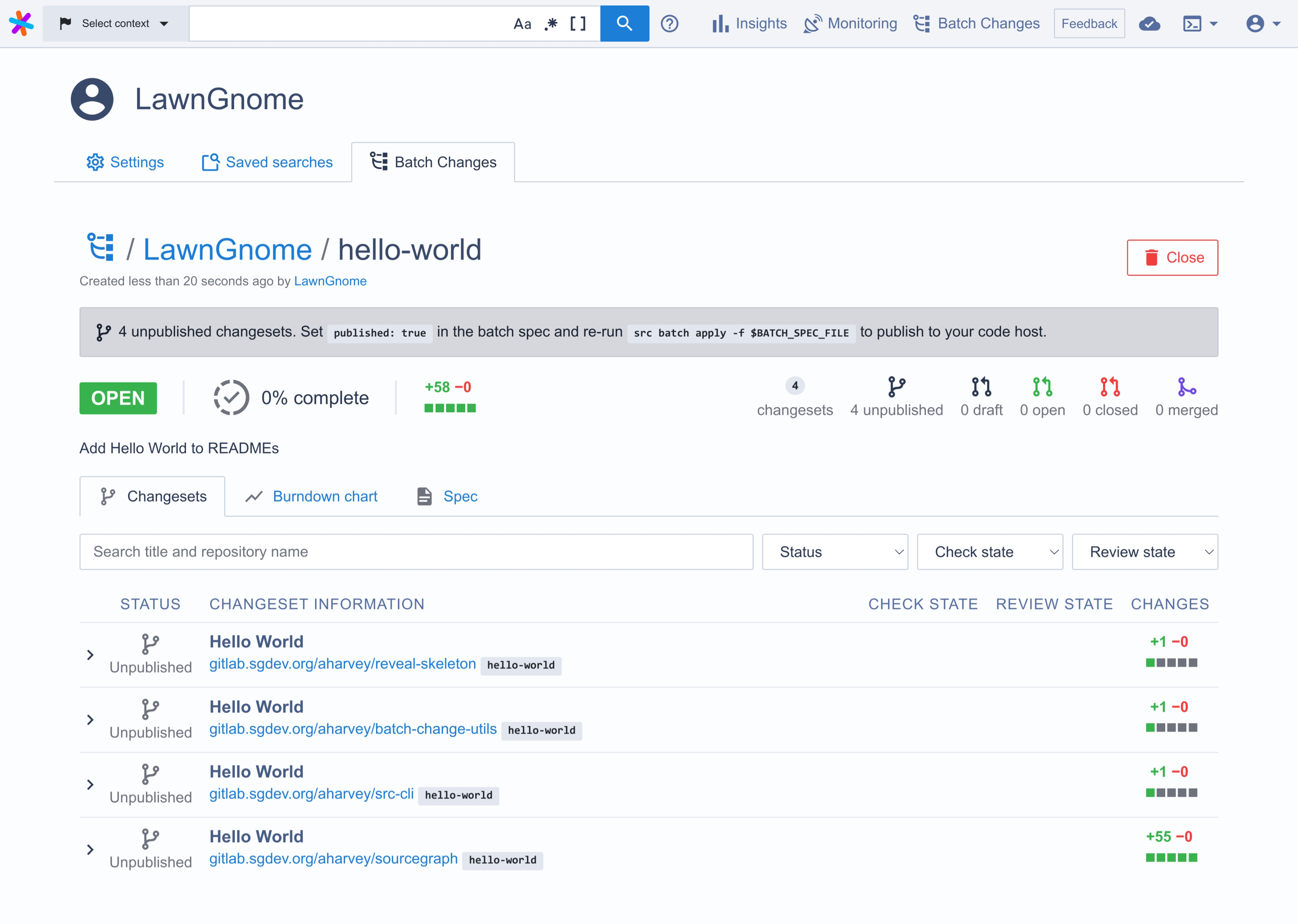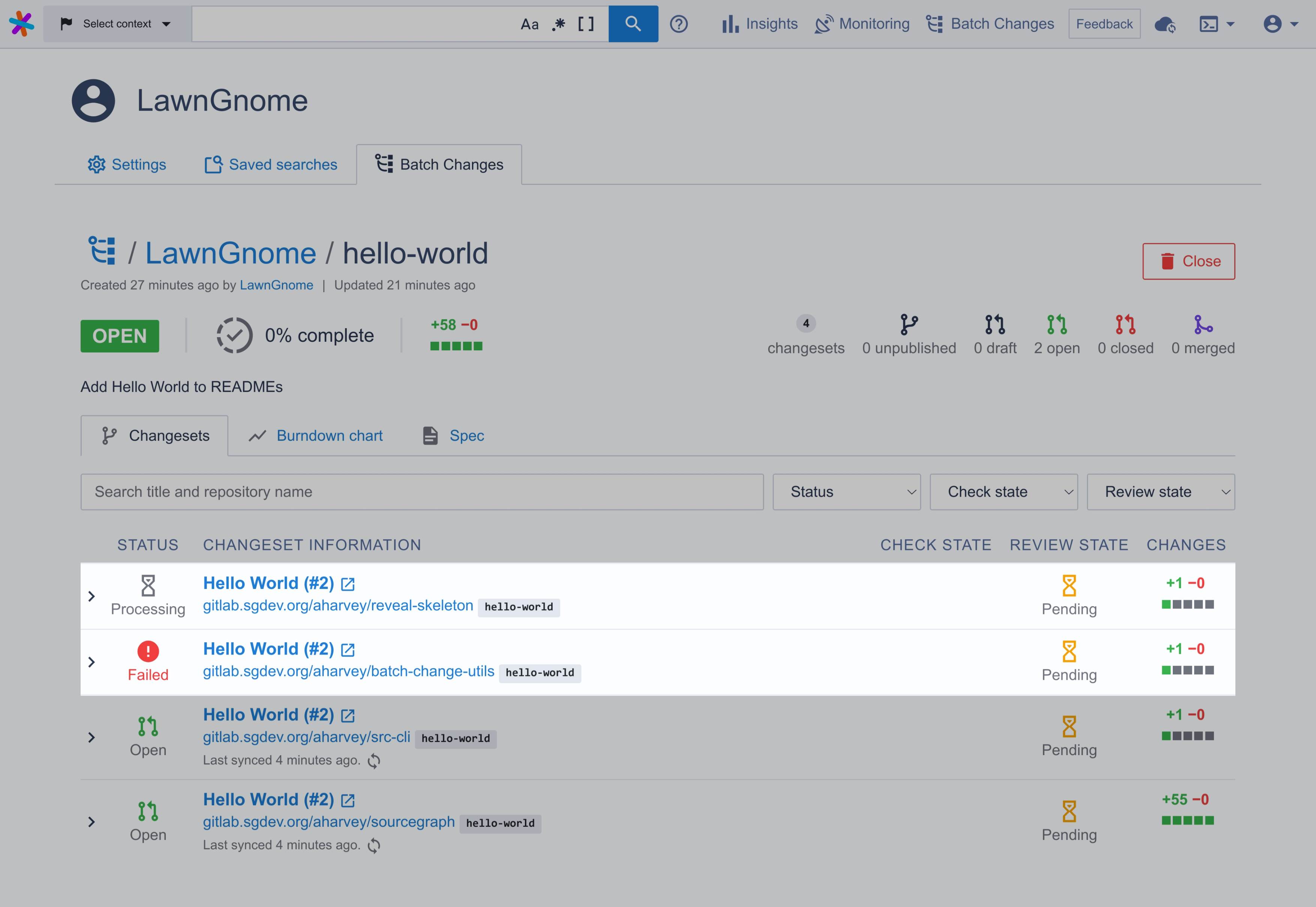After you've created a batch change with the published field set to false or omitted in its batch spec, you can see a preview of the changesets (e.g., GitHub pull requests) that will be created on the code host once they're published:
In order to create these changesets on the code hosts, you need to publish them.
To publish a changeset, you need:
- admin permissions for the batch change,
- write access to the changeset's repository (on the code host), and
- a personal access token configured in Sourcegraph for your code host(s).
For more information, see "Code host interactions in Batch Changes". Forking the repository is not yet supported.
You can publish changesets either by setting the published field in the batch spec, or through the Sourcegraph UI. Both workflows are described in full below.
A brief summary of the pros and cons of each workflow is:
| Workflow | Pros | Cons |
|---|---|---|
|
Setting
published in the batch spec
|
|
|
|
Publishing from the UI
|
|
|
When you're ready, you can publish all of a batch change's changesets by changing the published: false in your batch spec to true:
name: hello-world
# ...
changesetTemplate:
# ...
published: trueThen run the src batch preview command again, or src batch apply to immediately publish the changesets.
Publishing a changeset will:
- Create a commit with the changes from the patches for that repository.
- Push a branch using the branch name you defined in the batch spec with
changesetTemplate.branch. - Create a changeset (e.g., GitHub pull request) on the code host for review and merging.
NOTE: When pushing the branch Sourcegraph will use a force push. Make sure that the branch names are unused, otherwise previous commits will be overwritten.
In the Sourcegraph web UI you'll see a progress indicator for the changesets that are being published and any possible errors:
If you run into any errors, you can retry publishing after you've resolved the problem by running src batch apply again.
You don't need to worry about multiple branches or pull requests being created when you retry, because the same branch name will be used and the commit will be overwritten.
Instead of publishing all changesets at the same time, you can also publish some of a batch change's changesets, by specifying which changesets you want to publish in the published field:
# ...
changesetTemplate:
# ...
published:
- github.com/sourcegraph/src-cli: true
- github.com/sourcegraph/*: true
- github.com/sourcegraph-private/*: falseSee changesetTemplate.published in the batch spec reference for more details.
Some code hosts (GitHub, GitLab) allow publishing changesets as drafts. To publish a changeset as a draft, use the 'draft' value in the published field:
# ...
changesetTemplate:
# ...
published: draftSee changesetTemplate.published in the batch spec reference for more details.
If you have previously published changesets as drafts on code hosts by setting published to draft, you then fully publish them and take them out of draft mode by updating the published to true.
See changesetTemplate.published in the batch spec reference for more details.
NOTE: This functionality requires Sourcegraph 3.30 or later, and also requires
src3.29.2 or later.
To publish from the Sourcegraph UI, you'll need to remove (or omit) the published field from your batch spec. When you first apply a batch change without an explicit published fields, all changesets are treated as unpublished.
Once applied, you can select the changesets you want to publish from the batch change page and publish them using the publish bulk operation, as demonstrated in this video:
Regardless of how you publish your changesets, the commit that's created and pushed to the branch uses the details specified in the batch spec's changesetTemplate field.
See changesetTemplate.commit for details on how to set the author and the commit message.

